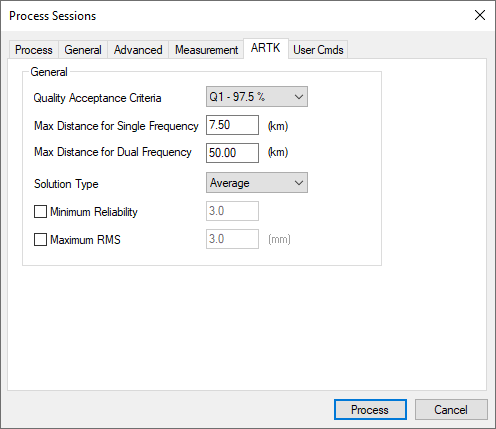ARTK Options

Quality Acceptance Criteria
The criteria used in statistical testing in order to accept or reject an ARTK fix. Consider increasing this value if the solution type of vectors in your network indicate fixed solutions, and high loop, check, or duplicate ties are reported in the traverse report.
The higher this threshold is set, the less likely it is that incorrect integer ambiguities will be accepted. Conversely, the higher this is set, the less likely any fixed integer solution will be achieved.
Maximum Distance for Single Frequency
Controls the maximum distance at which a fixed integer solution will be attempted using ARTK for single frequency data.
Maximum Distance for Dual Frequency
Controls the maximum distance at which a fixed integer solution will be attempted using ARTK for dual frequency data.
Solution Type
Whenever there is a change in satellite geometry (i.e. a new satellite rises or one drops from view), GrafNet attempts to recompute fixed integer ambiguities. A history of fixed integer solutions throughout the session is saved and the solution GrafNet chooses is controlled by this option. The default is to average all available ARTK fixes but choosing the solution with lowest (best) variance, lowest (best) RMS or highest (best) reliability may help when troubleshooting a problematic baseline. In order to evaluate the effectiveness of each option, check the magnitude of the loop and check and duplicate ties in the traverse report.
Minimum Reliability
ARTK will not return a successful solution unless the reliability of the ARTK fix meets this threshold. This option is off by default.
Maximum RMS
ARTK will not return a successful solution unless the RMS of the ARTK fix meets this threshold. This option is off by default.